Executive Summary
This report presents the documented design of the Yes2Life mobile application for Life Insurance Inc. based in Brisbane Australia. The document defines the background of the Client Company, business scenario, and scope of the project. The projected challenges in the development process are highlighted as well as the software features that need to be implemented. A time management plan as well as task sequencing and work breakdown structure are documented to illustrate how the project will be approached. It also includes an organizational chart and a UML diagram of the proposed system. Lastly, the constraints and limitations on the design and assumptions made are discussed.
Background Information about the Client
One of the nation’s most technologically advanced life insurance solution providers is Life Insurance Inc. The company offers a comprehensive range of custom insurance policies and services to help customers secure what is essential to them. The company is supported by a staff of knowledgeable and ebullient experts, a solid capital foundation, and reinsurance connections with reputable global partners. The goal of Life Insurance Inc. is to offer the best insurance products. They regularly assess their product selection to satisfy the evolving requirements of the customers in order to fulfill their mission. The company was established in 1987, after which it became public and started doing business. The business only has operations in Brisbane right now, but it intends to expand them across the entire country. The corporation currently has six major divisions: finance, human resources, logistics, operations, information technology, and brand management. Below the chief executive officer, there is a leader for every department. A budget of A$350k was granted by the operations department’s chief operations officer for the creation of a new customer-engagement business model. As a result, the company intends to move forward with the creation of a new mobile application to engage with clients and offer brush-offs based on their active lifestyles. Although the company management staff are exposed to technology, their understanding of the technology itself is limited. As a result, there is a need to get in touch with experts to guide and enlighten them on the development of the proposed mobile system.
Business Scenario
Life Insurance Inc. intends to develop a mobile application for its clients with social connection capabilities and features. The main goal of the mobile application is to allow users to enter information into a health “track record.” Each record might be for a sporting event like a basketball game, a run, a swim, a cycle, or monitoring of a health metric like blood pressure or heart rate during rest. Waist and weight values could be used as additional health indicators. Users will be able to monitor their progress and review their performance over time. Although there are now a number of comparable solutions, the company desired to introduce a distinctive feature to set itself apart. That is, the users will be able to interact with each other as it happens on conventional social media platforms such as Facebook, Twitter, and Instagram. When utilizing the mobile app to document their actions, customers should be able to “link” with acquaintances or other users. The firm wants users to be able to remark on and react to the diary posts that their linked friends submit. This functionality is identical to Facebook likes, reactions, and comments.
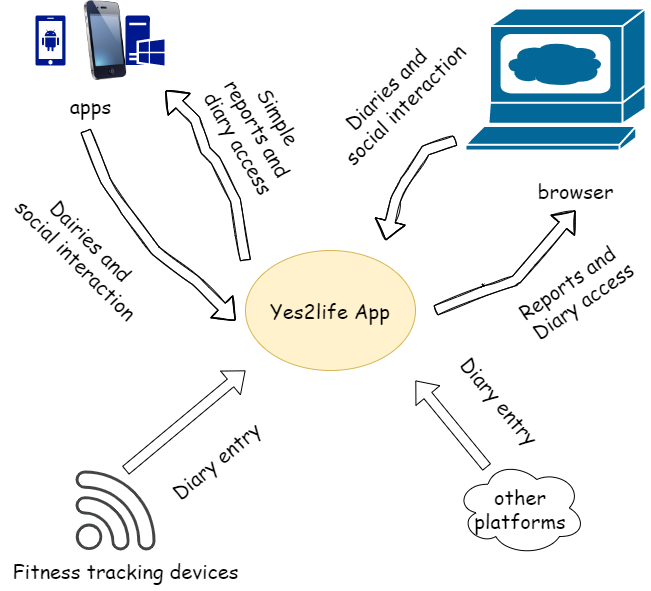
The mobile application will have different modules, each playing a distinct role and interacting with each other to achieve the overall goal. The module includes user profiles, data entries, social interactions, and progress reports. Although the target users are already clients of the business, they must register to use the mobile application. Customers who intend to participate in the challenges can choose to do this; it is not a requirement. As a result, they will be able to view the application from a variety of applications, devices, browsers, and internet-enabled services that they may have access to. Although the profile might be brief, it should offer users the chance to enter a variety of wellness and demographic details, including gender, location, age, weight, gender, and height, as well as any fitness-related objectives. Additionally, users have the option of adding a profile photo.
Data entry will be either manual or automated by connecting to fitness devices such as pulse rate trackers. The manual entries will be carried out through the mobile application, browsers, or any other accepted platform where users will type their records as required. There are numerous fitness monitoring gadgets on the market that monitor various exercises or measures. These include gadgets like wristbands from Fitbit or Jawbone that monitor a user’s daily step count or sleeping patterns, or gadgets employed by cyclists and runners to monitor routes or speed. Several other devices, including blood pressure, monitors only assess physiological parameters. The majority of gadgets enable users to submit device data to the Internet and can be synced with the mobile app. As a result, the mobile application must automatically sync with the devices and record the readings as long as they are in use. The application should not record all the data captured by the devices, but only essential chunks.
The interaction between application users should be implemented such that they can share their progress and reaction to the posts of others. A user should not be able to see or react to another user’s post without approval. That is only users who have approved engagements can interact with each other. The feature will be implemented with security in mind to enhance privacy ad data security. The feature is similar to Facebook friendships and posts will be visible on a continuous page comparable to the news feed.
Many individuals will be intrigued by the descriptive statistical options that the mobile app offers, in addition to the social characteristics of the platform that attract target consumers. They want the ability for users to build a variety of dashboards that can be used to evaluate progress and assessment over the period on the smartphone app. Presentations may be of straightforward measurements like blood pressure or weight that were chronicled over time in the subscriber’s journal. It may also be predicated on straightforward computations, like the overall amount of calories burned or the weekly mileage traveled.
The Design Problem
The company is just considering creating the new app as the first stage of execution. The phase one solution is ignoring the claims transaction processing, even though they are required for the incentives to be reflected. The second stage will tackle integration-related topics. Only the prerequisites for step one must be developed by the group as a requirements document. Such development and planning conditions risk failing to preempt all resulting problems as they occur. It implies that the application may not be developed as required. The conflicts resulting in the differences between the development phases may be transited from one step to the next, affecting the overall success and acceptability of the project.
Time Management Plan
By definition, a project has a start date and a finish date. All projects need a timetable in order to reach this deadline, and team members must regulate their own and each other’s time to keep the schedule on track. The proper planning spent and project task and activity completion is known as time management (Avlijas, pp 11-23). Planning, scheduling, monitoring, and managing all project operations are necessary for effective time management. According to the Project Management Institute, one of the six core roles of project planning is time management (Ibadov, p 4999). Some individuals include the methods and tools for completing tasks when they talk about timelines. In the completion of the project, the time management venture, all activities will be completed as described in the seven-step process below.
The project plan is presented in the figure below and described in the section that follow.
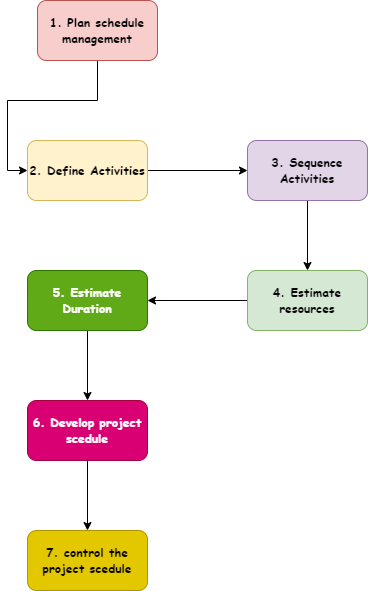
Plan schedule management
Usually, most project documents do not define a time management plan, yet it is an essential part of project management. According to the project management plan, mobile application release should be based on the recourses, employees’ availability, and the estimated time for completing the analysis, development, testing, and production stages. In this step, the project manager identifies available resources and tries to answer questions such as:
- What resources are available?
- Who will be using the resources?
- How frequently should the resources be used?
- What control measures will be adapted to oversee the utilization of resources?
- When should the deliverables be submitted?
For the company, developing a mobile application includes selecting the employees, software and hardware, and the control methods, such as reports. The deliverables require additional consultancy with company executives and a specific release date setting.
Define activities
After identifying the resources, it is time to establish the project activities, dependency on one another, and the time needed to complete each. The output of this step is presented in the work breakdown structure (WBS) in later sections of this report. The project milestones are also identified and planned to be accomplished within the project timeline.
Sequence activities
The project activities are known in this step and are arranged to be executed in the right and most effective order. In addition, the activities are presented in a network diagram showing their order and dependence on one another. Mobile application development has risk factors, such as employees or software unavailability, that might delay the tasks’ completion and order. Consequently, sequencing must be designed with sufficient time between activities and opportunities to make emergency adjustments.
Estimate resources
Project resources include people, time, finances, and computing tools. In this care, the time allocated to a task is dependent on the human resource available. For instance, the project at hand will be completed by one person. As a result, the amount of time should be reasonable enough to allow the completion of all tasks as required. The project manager should also consider the software and hardware recourses availability and the estimated quantity necessary for each activity to eliminate the shortage.
Estimate durations
The project activities and deliverables are known in this step. It is time to estimate the time needed to complete each task or deliverable such that the project is delivered within the deadline. A Gantt chart is used to determine the timeframes needed to complete the identified project activities necessary for the company and is presented in the following sections. A PERT is effective in instances where the factors affecting the completion of the project are many and complicated.
Develop the project schedule
The project schedule is accomplished using management tools such as MS Project where project and activity timelines are input and processed by the software. The respective project activities, start dates, computed durations, end dates, relationships, and sequencing orders are input into the management software for visual illustrations.
Control the schedule
A project schedule must be tracked and controlled to ensure the project resources do not skyrocket beyond the estimated budget. The project progress will be evaluated and rationalized regularly. The completed work will be compared against the plan to establish any areas that might be falling behind.
Work Breakdown Structure
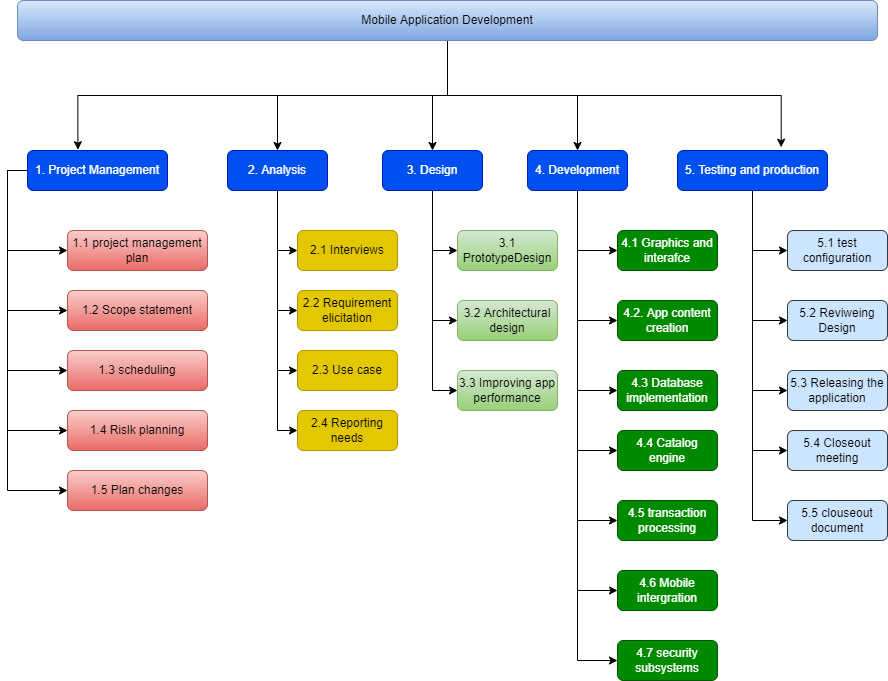
The work breakdown structure is broken down into five main tasks: project management, analysis, design, development, testing, and production. Each task is broken down into several tasks, depending on its nature and expected deliverables. For instance, the design part is broken down into only three tasks while the project management part comprises five parts. The development part is the most critical and contains the largest number of subtasks to be accomplished.
Task Sequencing Approaches
Most activities in software development are sequential, relying on the outputs of their precedents. Tasks that ought to be carried out in a priority format, at the very least, are known as sequential activities. The relationship between activities must be established before conceptualizing their sequence of execution. Conventionally, software engineering begins with requirement gathering and elicitation and ends with maintenance (Foglino et al., pp. 207-214). The sequencing approach considers three main issues: activity attributes, determining constraints, and establishing dependencies. One ought to have details about all activities. The details include name, identification number, descriptions, and accurate attributes of the specific task. Activities are limited and controlled by their respective constraints such as financial allocation, period, labor, and skill set. Noting such constraints helps establish the right way of scheduling each task. In identifying dependencies, the relationship between activities is established. Without correct knowledge of the activity dependencies, it is possible to schedule them incorrectly, resulting in project failure (Olajoyegbe). There are several types of dependencies such as Finish-to-Start, Finish-to-Finish, Start-to-Finish, and Start-to-Start. The overall tasks are presented in the sequence described below.
Requirement Gathering and Elicitation
Studying and compiling all of the specific needs of the project from beginning to end is the investigative process known as requirements gathering. Effective requirements engineering and specifications collection begin during the project’s early stages.
System Design
The different system components, modules, interfaces, databases, and other specific requirements are defined in this stage. Prototypes are produced to illustrate the performance of the proposed or expected system in accordance with the client’s needs and requirements.
Implementation
This is the actual coding phase where the system design is converted into functioning computer programs. The choice of the programming language used here is subject to client needs, technology constraints, or any other limiting factor established during requirement gathering.
Testing
The program is subjected to various types of tests including unit, module, integration, and acceptability tests to ensure it performs as expected. The acceptability test ensures the client is satisfied with the final product as described during the requirement gathering and elicitation. If a test fails, the necessary measures are taken to correct the defect before proceeding to the next phases.
Deployment
Once the software is completely developed, it will be installed on the target devices and platforms. In this case, the mobile application will run on mobile devices, be accessed via conventional browsers, and integrate with wearable devices.
Maintenance
This is the longest and most expensive stage of software development. The mobile application will be subjected to updates, adding or removing modules to adapt to the company’s needs, client’s requirements, and any other emerging needs. The sequence of events is summarized in the Gantt chart and network diagram below.
Figure 4: Gantt chart

The Gantt chart and the network diagram summarize the sequence of activities in the entire development timeline.
Fact Finding
The development of a software product is based primarily on user needs, popularly known as requirements. The information collected during the requirement gathering process is recorded in a Software requirement specification document (SRS) (Tilley, 2019). The document is recorded by a member of the project team and captures what the user expects the system to look like or do. As a result, there are two types of requirements, both of which must be documents. Functional requirements define what the system should do (Alzahrani, pp 15-36). For instance, in this case, users should be able to share their process with their “friends”. This is a part of the mobile applications social feature which is a mandatory requirement as expressed by the organization. Nonfunctional requirements define the characteristics of a system, for example, loading speed, interface colors, security features, and modularity. Such characteristics do not express what the system can do, but rather, how it should do it.
The requirements are gathered using fact-finding techniques which help understand business logic and customer expectations. In this context, several data collection tools will be used including questionnaires, interviews, observations, and inboard meetings. The fact-finding mission will keenly seek to understand how the company carries out its operations in order to come up with a solid foundation for the development of the proposed system. The questionnaires will be provided to staff at all levels, including the managers and the chief executive officer. The move is intended to ensure a detailed report is compiled to guide the development process. Interviews’ are resource-intensive and time-consuming and will be carried out on target groups, specifically management personnel and a few low-ranking employees. In case conflicting requirements are established, their contributing parties will be approached to resolve the dispute. Usually, such scenarios are best resolved through meetings where the parties conceptualize the top-level business operations in their roles and the organization at large.
Organizational chart
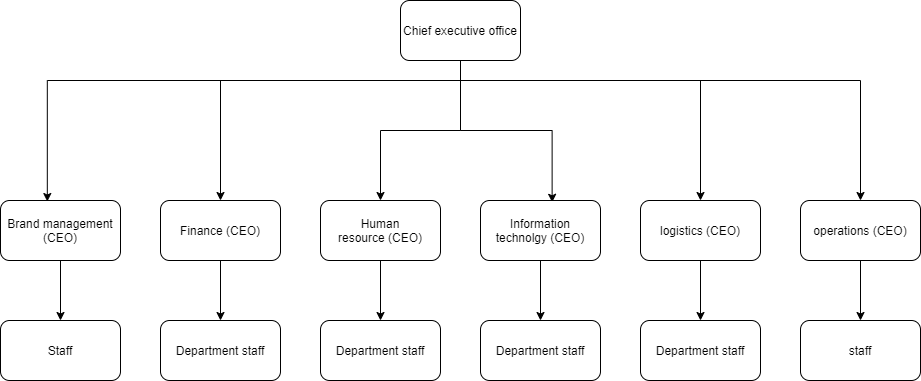
The company is headed by the chief executive officer who is in charge of all financial and operational decision-making processes. It is comprised of six departments namely brand management, finance, human resources, information technology, logistics, and operations. Each department is run by a manager, also referred to as the chief office in the company doctrine. Below the departmental heads are a team of staff who work to achieve the goals and missions of the respective departments. The IT department is possible for providing the technological support and resources needed to keep the company operations running smoothly and effectively. The operations department is tasked with planning the company activities on a day-to-day basis. The human resource department recruits staff based on the needs and requirements of other departments. The finance departments oversee the company’s monetary transactions and process employee, and client payments. It is also responsible for the procurement of company products and services. The brand management department is tasked with popularizing the company, its operations, goods, and services to the general public in current as well as target markets.
The “To Be” Process
The proposed system is represented in the UML diagram below. It illustrates the relationship between users, activities, social connections, and rewards. Users create accounts and record activities that can be shared with their social connections. Best performing individuals will be rewarded based on the performance of their activities. The synchronization between wearable devices and the system is also included. Users will connect their devices to the supplication and essential data will be uploaded to the system.
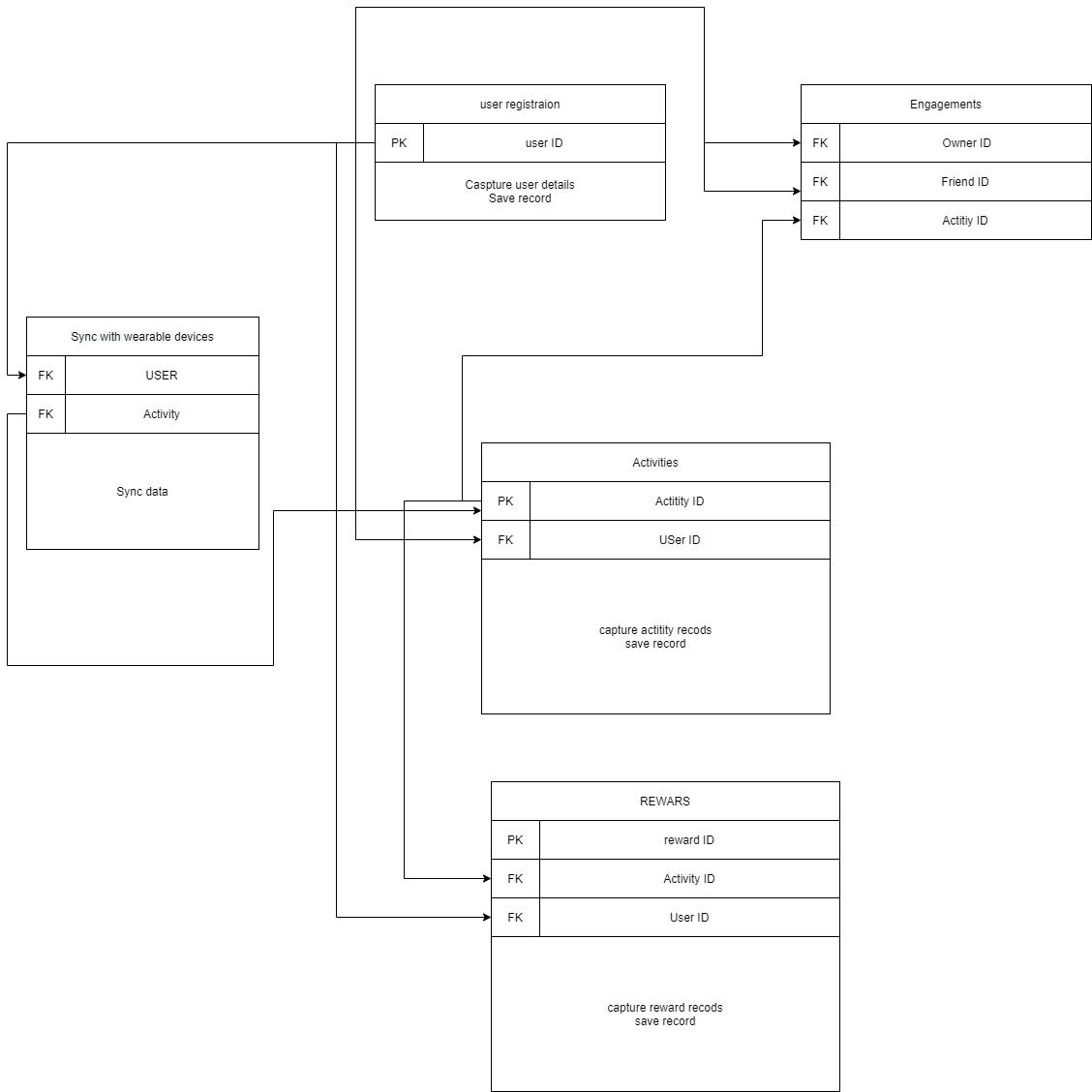
Constraints and Limitations on the Design and Assumptions Made
Once the project scope has been defined, it is possible to be subjected to changes that could affect its overall success. The design does not create room for possible changes in scope which could affect the project delivery deadline. The design process assumes that the development process will not entail any flaws or result in major errors and bugs. It is also assumed that the development team has the right skill set to develop the software as required by the client. The information collected during the requirement gathering and elicitation is enough and there will not be any major changes in the project scope during later development stages.
Reference List
Alzahrani, Abdullah AH. “Analyzing the factors impacting the choice of the fact-finding technique for requirements elicitation.” International Journal on Information Technologies & Security 12, no. 1 (2020): 15-36. Web.
Avlijas, G., 2019. “Examining the value of Monte Carlo simulation for project time management”, Management: Journal of Sustainable Business and Management Solutions in Emerging Economies, 24(1), pp.11-23. Web.
Foglino, F., Christakou, C.C. and Leonetti, M., 2019, August. “An optimization framework for task sequencing in curriculum learning”. In 2019 Joint IEEE 9th International Conference on Development and Learning and Epigenetic Robotics (ICDL-EpiRob) (pp. 207-214). IEEE. Web.
Olajoyegbe, T.O., Utilizing Bayesian Inference for Data-Driven Optimization in Facilities Configuration and Task Sequencing under Smart Manufacturing. PhD thesis. University of Georgia. Web.
Tilley, S., 2019. Systems analysis and design. Cengage Learning.